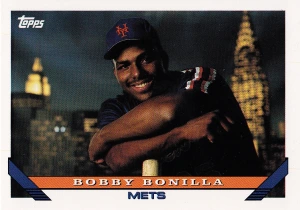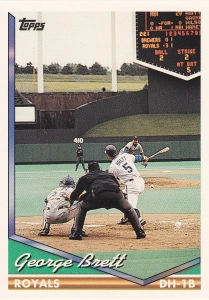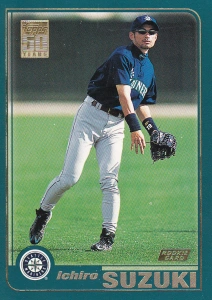 Here’s my overview of the ’84 season in baseball. I was 4 years old in 1984, maybe just starting to play wiffle ball sports. Maybe just now old enough feel good about beating my 2-year-old brother in tee-ball. I’ve mentioned this before, but I have no memory of sports before Pete Rose was with the Reds. Well, Rose started the season with the Expos, but he ended it back in Cincinnati. I doubt I really knew anything about the Reds yet, though – I sort of remember Pete breaking the record. Pete’s return was the big baseball news in Cincinnati – along with the return at the start of the year of Big Red Machiner Tony Perez.
Here’s my overview of the ’84 season in baseball. I was 4 years old in 1984, maybe just starting to play wiffle ball sports. Maybe just now old enough feel good about beating my 2-year-old brother in tee-ball. I’ve mentioned this before, but I have no memory of sports before Pete Rose was with the Reds. Well, Rose started the season with the Expos, but he ended it back in Cincinnati. I doubt I really knew anything about the Reds yet, though – I sort of remember Pete breaking the record. Pete’s return was the big baseball news in Cincinnati – along with the return at the start of the year of Big Red Machiner Tony Perez.
Highlights and Events:
The offseason between 1983 and 1984 was significant for off-the-field news as much as free agent signings. In November, 4 prominent players (Vida Blue, Willie Wilson, Willie Aikens, Jerry Martin) were sent to short prison terms for attempting to purchase cocaine. This was the first hint of the drug scandal that plagued the sport in the 1980s. Additionally, the MLBPA fired its head Ken Moffett, and hired Donald Fehr as his successor. Except for Marvin Miller, Fehr is the most successful PA leader in the Players’ ongoing struggles with MLB.
The headline off-season player movement was when the Mets left Tom Seaver unprotected and he was surprisingly selected as a free agent compensation pick by the White Sox. This would leave a slot rotation spot open for Mets prospect Dwight Gooden. Gooden picked up his first career win April 7th, and would go on to lead the majors in strikeout, tie a major league record with 32 K’s over 2 consecutive starts, combine with former rookie phenom, Fernando Valenzuela, to strikeout 6 straight American Leaguer’s in the All-Star game. In one of the greatest rookie pitching seasons ever, Gooden went on to a near-unanimous selection as the NL Rookie of the Year.
Seaver had a notable achievement in his first season with the White Sox. On May 8th, a game against the Brewers was suspended in the 17th inning at 3-3. When the tie lasted 8 more innings the next day, Seaver, slated to start the 2nd game, was the only remaining pitcher and wound up picking up the win in relief. After earning the victory as the starter the next day, Seaver had picked up 2 wins in the same day! For the day, the 39-year old Seaver pitched 9+ innings allowing just 4 hits.
Pete Rose tested free agency for the 2nd time, this time signing with the Montreal Expos. In early April, Rose doubled off of Phillies veteran Jerry Koosman to follow Ty Cobb as the 2nd player ever to reach 4,000 hits.
Willie Hernandez was traded to by the Phillies to Detroit at the end of March, just before the start of the season. Hernandez would go on to be the Cy Young and MVP for as closer for the World Champion Tigers. Detroit started the season off as hot as anyone in history. Jack Morris no-hit the White Sox on April 7th, jump starting his own season and tha of the Tigers. The Tigers started 35-5, the best 40-game start in MLB history. Morris himself was 9-1 in those first 40 games.
On May 4th, Frank Viola and Dave Kingman combined for a first in Metrodome history. Viola hurled a low pitch to the free-swinging Kingman, who lifted the pitch up to the ceiling and through a drainage hole in the roof. He was awarded a ground rule double.
The Cubs were involved in 2 significant in-season trades. In May, Dennis Eckersley was sent to Chicago in exchange for Bill Buckner. Eck would have a positive impact on the Cubs playoff run, going 10-8 with a 3.03 ERA. Former batting champ Buckner was another addition to a very good lineup in Boston that would make its own run a few years down the line.
In June, the Cubs also traded prospect Joe Carter and others to the Indians for Rick Sutcliffe and catcher Ron Hassey. Sutcliffe had been struggling for the Indians at the time, but he was nearly unbeatable for Chicago, beating out Rookie Phenom Gooden to win the Cy Young award after going 16-1 in the National League. On September 24th, 15 years to the day after the ’69 Mets had eliminated the Cubs, Sutcliffe pitched a 2-hitter to help the team to the playoffs for the first time in 39 years.
 In August, Rose’s career came full circle – he was traded by Montreal back to the Reds, replacing Vern Rapp as the team’s manager after an unsuccessful season in Cincinnati. Rose would be the last player-manager in baseball.
In August, Rose’s career came full circle – he was traded by Montreal back to the Reds, replacing Vern Rapp as the team’s manager after an unsuccessful season in Cincinnati. Rose would be the last player-manager in baseball.
For the first time, a baseball tournament was held in the Summer Olympic games Played in Dodger Stadium in Los Angeles, the games were played as a demonstration sport, which meant that medals awarded to the winners were not official. The 8 teams were split into 2 groupings and played “round robin” in the preliminary rounds. The top 2 teams from each division made the semi-finals, and Japan beat the team of United States collegians, 6-3, in the final. The U.S. team included future All-Stars Mark McGwire (USC), Will Clark (Mississippi St.), Barry Larkin (Michigan) and B.J. Surhoff (North Carolina).
There were a number of milestones reached in 1984.
- Phil Niekro celebrated Independence Day by becoming the 9th pitcher to record 3,000 career strikeouts (Nolan Ryan struck out his 3,000th on the same day 4 years earlier).
- During the year, Ryan replaced Steve Carlton permanently as the all-time strikeout king.
- At the All-Star game in Candlestick Park in July, Gary Carter homered to become just the 3rd player to win 2 All-Star Game MVPs, joining Willie Mays and Steve Garvey (Cal Ripken has since joined this group).
- As mentioned, Pete Rose became just the 2nd player with 4,000 hits. He also joined Cobb as the 2nd player with 3,000 singles, and broke Cobb’s career singles record in July (3,053).
- Rose also became the first player with 22 consecutive seasons of 100 hits, and he broke Stan Musial’s National League record for career doubles (726).
- Another record for Rose – on June 29th, he played in game #3509 of his career, passing Carl Yastrzemski in front of his former hometown fans at Riverfront Stadium. He went 0-for-5, but the Expos won 7-3.
- Reggie Jackson hit his 500th home run on September 17th in Kansas City, where he started his career 17 years earlier.
- On the last day of the season, September 30th, Mike Witt pitched a perfect game, hurling the Angels to a 1-0 win over the Texas Rangers.
 Mike Schmidt was still the best hitter in baseball (I look at the previous 3 and 5-year stretch in analyzing this) – but for the first time, he had some company challenging that role in Robin Yount, and Dale Murphy. The best pitcher in baseball was becoming a little less clear-cut.
Mike Schmidt was still the best hitter in baseball (I look at the previous 3 and 5-year stretch in analyzing this) – but for the first time, he had some company challenging that role in Robin Yount, and Dale Murphy. The best pitcher in baseball was becoming a little less clear-cut.
Steve Carlton was no longer the best pitcher in baseball – I think the decision would have to go to one of two pitchers, and I’d pick Dan Quisenberry. Quiz had followed up his record-breaking 45 save season with 44 saves, this time for a playoff team. He was in the 3rd year of a 4-year stretch where he was in the top 3 in each Cy Young vote. Dave Stieb would also be in the argument, though he was underappreciated. In that same 4-year stretch, Stieb pitched over 265 innings and posted an ERA that got progressively better from 3.25 to 2.48. Since Stieb is a starter, his value stats like WAR and Win Shares look a little better, but I would have to give the nod to Quiz for his sheer dominance during the early 80’s. Mario Soto was easily the NL’s best pitcher during this time frame, but was clearly behind these 2 guys.
Playoffs:
This was the first postseason under the leadership of new commissioner Peter Ueberroth. On October 1st, the leadership of Major League Baseball transferred from Bowie Kuhn to Ueberroth, who was the 6th commissioner of MLB.
 Led by a breakout season by Tony Gwynn, who won his first batting title, and some veteran additions over the previous two years – Steve Garvey, Goose Gossage and Graig Nettles – the Padres clinched their first division title. They matched up against the Cubs, who were bolstered by newcomers of their own described above – and by NL MVP Ryne Sandberg, who notched 200 hits and scored 114 runs in his 3rd year. So the World Series would either feature the Cubs, who had been out of the playoffs since 1945, or the Padres, in their first playoff series ever.
Led by a breakout season by Tony Gwynn, who won his first batting title, and some veteran additions over the previous two years – Steve Garvey, Goose Gossage and Graig Nettles – the Padres clinched their first division title. They matched up against the Cubs, who were bolstered by newcomers of their own described above – and by NL MVP Ryne Sandberg, who notched 200 hits and scored 114 runs in his 3rd year. So the World Series would either feature the Cubs, who had been out of the playoffs since 1945, or the Padres, in their first playoff series ever.
The Cubs won the first two games of the series in Wrigley Field and looked poised to clinch in game 3, with a 1-0 lead going into the bottom of the 5th inning. But the Padres scored 3 runs in the 5th, and won the last 3 games – all played at Jack Murphy Stadium – to clinch their first World Series berth. The lovable losers continued their curse – they hadn’t won a World Series since 1908.
The Padres set to face off against the Detroit Tigers, who rode their hot start to 104 wins and a sweep of the Royals in the ALCS. Former Big Red Machine manager Sparky Anderson, who had become the first manager to win 100 games in both leagues and was trying to become the first to lead a World Series winner from both circuits. The teams split the first two games, but the Tigers won the next 3 behind heavy hitting from the 2 and 3 spots – series MVP Alan Trammel and slugger Kirk Gibson.
World Series:
In the top of the 8th inning of game 5, the Padres scored a rare run of AL MVP Hernandez to pull within 1 run. Goose Gossage let 2 runners on base before Trammell sacrificed the runners to 2nd and 3rd. Up came Gibson, and manager Dick Williams came out to instruct Gossage – one future Hall-of-Famer to another – to walk Gibson. The chatter between Sparky and Gibson was caught on camera, with Sparky saying “he don’t want to walk you”; Gibson supposedly bet Anderson that Gossage would pitch to him. Gossage didn’t want to walk Gibson, and talked his skipper out of it. Gibson responded by smashing a 3-run blast to the upper deck of Tiger Stadium, effectively sealing the Padres’ doom and winning the Tigers their first World Series since 1968. Coincidentally, this would only be Gibson’s 2nd most famous World Series home run.
The Tigers became 3rd team to go 1st place wire-to-wire and win the World Series. (1927 NY Yankees, 1955 Brooklyn Dodgers). They were the first to do so in the expansion era. Only the Tigers and the ’27 Yankees had gone wire-to-wire without ever trailing in the postseason (the ’55 Dodgers trailed 3-2 before winning the last two games against the vaunted Yanks). Both these feats were matched by the Cincinnati Reds 6 years later.






[…] 1984 — Montreal Expos’ veteran Pete Rose played in a MLB-record 3,309th game, surpassing Boston Red Sox legend Carl Yastrzemski. (More info.) […]
[…] 1984 — Montreal Expos’ veteran Pete Rose played in a MLB-record 3,309th game, surpassing Boston Red Sox legend Carl Yastrzemski. (More info.) […]
[…] 1984 — Montreal Expos’ veteran Pete Rose played in a MLB-record 3,309th game, surpassing Boston Red Sox legend Carl Yastrzemski. (More info.) […]